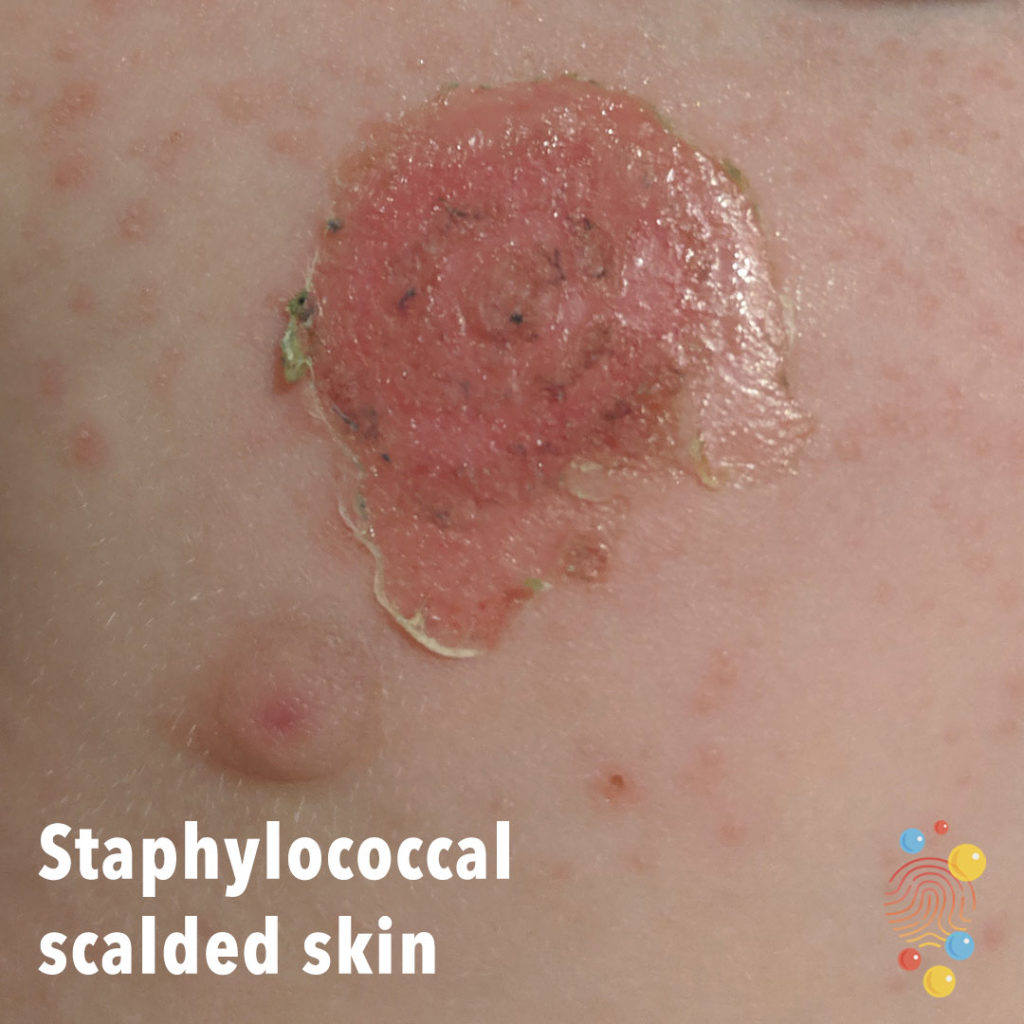Staphylococcal Scalded Skin Syndrome | These toxins attack the epidermal layer of the skin causing it to break down. Certain strains of staphylococcus aureus produce exfoliative certain strains of staphylococcus aureus produce exfoliative toxins. Staphylococcal scalded skin syndrome symptoms. J eur acad dermatol venereol. Staphylococcal scalded skin syndrome is a dermatological condition caused by staphylococcus aureus.
Staphylococcal scalded skin syndrome (ssss), also known as ritter's disease, is a blistering skin disease caused by a toxin produced from a two epidermolytic toxins (a and b) are the culprit of this syndrome. Staphylococcal scalded skin syndrome differs from bullous impetigo. However, in bullous impetigo, the exfoliative toxins are restricted to the area of infection, and bacteria can be cultured from the blister contents. Diagnosis and management in children and adults. This bacteria produces a chemical called an epidermolytic toxin (epiderm, deriving from the.

Both are blistering skin diseases caused by staphylococcal exfoliative toxin. It looks like the skin has been scalded or burned by hot liquid. The condition normally starts with a fever, sensations of irritability and a widespread redness of skin. Staphylococcal scalded skin syndrome (ssss) is a dermatological condition caused by staphylococcus aureus. Previous terms for ssss in newborn infants include ritter's disease and pemphigus neonatorum. Reviewed and further updated by jannet gomez, postgraduate student in clinical dermatology, queen mary university, london, united. Staphylococcal scalded skin syndrome differs from bullous impetigo. In young infants, and in those with renal impairment, these can accumulate and. Ssss or staphylococcal scalded skin syndrome is a skin condition caused by toxic strains of the bacteria, staphylococcus aureaus. In staphylococcal scalded skin syndrome (ssss), cells of the o… ssss involves a reddening and wrinkling of the skin that typic… Staphylococcal scalded skin syndrome, arch. This bacterium produces an exfoliative toxin that causes the outer layers of skin to blister and peel, as if they've been doused with a hot liquid. Staphyloccocal scalded skin syndrome is caused by staph infection.
Staphylococcal scalded skin syndrome, arch. Epidemiological data of staphylococcal scalded skin syndrome in france from 1997 to 2007 and microbiological characteristics of staphylococcus aureus associated strains. Dr amanda oakley, dermatologist, waikato hospital, hamilton, new zealand, 2002; This bacteria produces a chemical called an epidermolytic toxin (epiderm, deriving from the. Several natural treatments for staphylococcal scalded skin syndrome focus on eliminating infection, moisturizing the skin and supporting regrowth of healthy skin.

Several natural treatments for staphylococcal scalded skin syndrome focus on eliminating infection, moisturizing the skin and supporting regrowth of healthy skin. However, in bullous impetigo, the exfoliative toxins are restricted to the area of infection, and bacteria can be cultured from the blister contents. Authored by dr mary harding lamand v, dauwalder o, tristan a, et al; The infection causes peeling skin over large parts of the body. Pemphigus neonatorum, ritter's disease, 1 localized bullous impetigo. Dr amanda oakley, dermatologist, waikato hospital, hamilton, new zealand, 2002; Staphylococcal scalded skin syndrome symptoms. Staphylococcal scalded skin syndrome (ssss) is a serious skin infection. Staphylococcal scalded skin syndrome (ssss) is an uncommon, superficial blistering skin condition, characterised by widespread erythema and exfoliation, mainly occuring in children under five years of age, although older children and adults can be affected. Bullous impetigo is a bacterial skin infection caused by staphylococcus aureus that results in the formation of large blisters called bullae, usually in areas with skin folds like. J eur acad dermatol venereol. Staphylococcal scalded skin syndrome (ssss) is a disease, caused by a type of bacteria, in which large sheets of skin may peel away. Staphylococcal scalded skin syndrome (ssss) is a potentially serious acute skin condition caused by the exfoliative toxins of staphylococcus aureus and typically affects infants and young children.
Bullous impetigo is a bacterial skin infection caused by staphylococcus aureus that results in the formation of large blisters called bullae, usually in areas with skin folds like. J eur acad dermatol venereol. Staphylococcal scalded skin syndrome symptoms. A skin infection characterized by damaged, shedding skin patches, staphylococcal scalded skin syndrome is a progressive disorder. Diagnosis and management in children and adults.

The condition normally starts with a fever, sensations of irritability and a widespread redness of skin. Both are blistering skin diseases caused by staphylococcal exfoliative toxin. This bacterium produces an exfoliative toxin that causes the outer layers of skin to blister and peel, as if they've been doused with a hot liquid. In staphylococcal scalded skin syndrome (ssss), cells of the o… ssss involves a reddening and wrinkling of the skin that typic… Staphylococcal scalded skin syndrome (ssss), also known as ritter's disease, is a blistering skin disease caused by a toxin produced from a two epidermolytic toxins (a and b) are the culprit of this syndrome. The infection causes peeling skin over large parts of the body. Staphylococcal scalded skin syndrome, arch. Staph bacteria releases two types of toxin exfoliatin a and exfoliatin b. Staphylococcal scalded skin syndrome (ssss) is a potentially serious acute skin condition caused by the exfoliative toxins of staphylococcus aureus and typically affects infants and young children. Infants and children are most susceptible. Staphylococcal scalded skin syndrome (ssss) is the clinical term used for a spectrum of blistering skin diseases induced by the exfoliative (epidermolytic) toxins (et) of staphylococcus aureus.1 current synonyms include ritter's disease, bullous impetigo, pemphigus neonatorum, and. Reviewed and further updated by jannet gomez, postgraduate student in clinical dermatology, queen mary university, london, united. Staphylococcal scalded skin syndrome (ssss) is a serious skin infection caused by the bacterium staphylococcus aureus.
Staphylococcal Scalded Skin Syndrome: This bacteria produces a chemical called an epidermolytic toxin (epiderm, deriving from the.
Referanse: Staphylococcal Scalded Skin Syndrome
Post a Comment